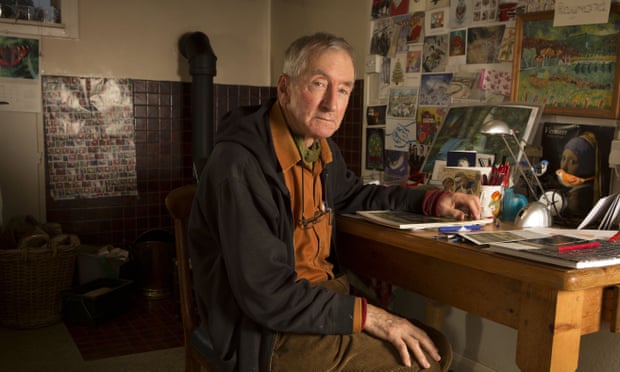Children’s authors disliking children has become a thing. It’s been said of Enid Blyton, AA Milne, Dr Seuss, Maurice Sendak, Shel Silverstein … and now we hear that the late, dear Raymond Briggs, the sweet grumpy writer and illustrator who became National Grandpa to millions of us who never met him, was another. Interviews with Briggs, who died last week aged 88, could be heard on the radio, saying for all to hear: “I’ve no interest in children. Didn’t want to have any.”
It’s dismaying. How could they?
As a writer, and daughter, partner and mother of writers, I can tell you: no writers like children – if said children are wanting things from the writer when the writer wants to be writing. This isn’t exclusive to any particular kind of writer, nor even to creative people. It’s true of everyone, as we know now after lockdowns requiring people to simultaneously work and school at home. (I avoided this with my child by making her a writer too, via the noble tradition of child labour. We wrote five books together, which were published in 36 languages and optioned by Spielberg, twice. Boom!)
But I don’t believe in this so-called dislike. First, of all the possible reasons for liking or disliking an individual, was there ever a dafter one of her age? And second, having no interest in children per seor not wanting kids yourself, isn’t dislike.
In 2015, in a Guardian interview with Sarah Hughes, Briggs points to a photo of the grandchildren of his late partner, Liz. “This one used to want to sit on my head,” he told her. “’I want to sit on his head,’ he’d say and climb up. It was lovely.” Then, she wrote, “I have stared into space for a moment.” Is this someone who dislikes children?
When Briggs was suggested as Children’s Laureate, the answer was “no, thank you… all that running all over the country, all the bookings and bed and breakfasts and railways. I don’t want to go to schools and give talks on children’s books. I don’t actually know anything much about children. I try to avoid them whenever possible.”
I suspect that individual or known children can be OK, but a mass of tiny maniacs and fuss is alarming to people who work in quiet. So is it really children that these writers aren’t keen on? Perhaps AA Milne just disliked that the success of his children’s books outshone the reputation he really desired, as a playwright. His son wasn’t happy with being Christopher Robin, writing of “toe-curling, fist-clenching, lip-biting embarrassment” and how “it seemed to me almost that my father had … filched from me my good name and had left me with the empty fame of being his son”. But there’s no suggestion Milne senior did that on purpose.
On the day of Sendak’s barmitzvah in 1942 in New York, his father learned of the destruction of the family in Europe. This was only part of the trauma that made his parents of him, in Maurice’s word, “crazy”. His dark topics about him were sometimes taken as an aggression to a young readership, an indication that he did not care for them. He said himself that if he’d come from a happy home he wouldn’t have become an artist. “I refuse to lie to children,” he said, apropos “the great 19th-century fantasy that paints childhood as an eternally innocent paradise”, and described his job as “the idiot role of being a kiddie book person”. He and his partner of him Eugene did not build a family because he was certain, from his family history of him, that he would mess it up. Again, I’m not convinced it’s children that he didn’t like.

Shel Silverstein, author and illustrator of The Giving Tree, didn’t like dull children’s books and was not initially keen to write for children. Plus he was a satirical Sixties guy with an eminently misunderstandable sense of humour, and a very sad story with his own daughter, who died young in the care of her relatives after the death of her mother. Heaven forbid that a children’s author be complex! (To some people he’ll always be the guy who wrote Sylvia’s Mother.)
The myth that Dr Seuss (Theodor Guisel) disliked children seems based on childlessness, which in the 1950s was pretty much held as evidence of disliking them – when in fact his wife, Helen Palmer, also a children’s writer, couldn’t conceive. During their lives they did have an imaginary daughter, Chrysanthemum-Pearl, who appeared on the Seuss Christmas cards.
Enid Blyton, we’re told – by her own daughter – was “without a trace of maternal instinct”. But we’re also told – by her other daughter of her – that she was a wonderful companion who could “communicate with children in a quite remarkable way, and not just on the page”.
But it doesn’t matter if writers can handle children’s more riotous aspects or not. They just need to have a handle on a child’s point of view – as they do on any character’s.
Humbug and sentimentality are greater enemies; books written to appeal to adults. I don’t mean books that naturally appeal to people of all ages: those are magic.
Briggs said: “People are always saying, ‘Well, who did you aim this at?’ and I keep replying, ‘Books are not missiles, you don’t aim them at anybody’.”
In wise words from US writer Edward Eager’s novel half-magic: “The four children divided all grownups into classes. Last and best and rarest of all were the ones who seemed to feel that children were children and grownups were grownups and that was that, and yet there wasn’t any reason why they couldn’t get along perfectly well and naturally together, and even occasionally communicate.”